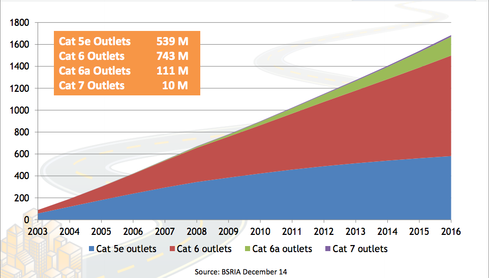2.5G & 5G Ethernet In The Wiring Closet
A new standards effort will help existing Ethernet cable investments support Wave 1 and Wave 2 802.11ac WiFi as well as off-loaded mobile carrier traffic.
September 11, 2015

The growing use of wirelessly connected smartphones, tablets, and nettops in the office is undeniable. The availability of faster Wave 1 802.11ac WiFi connectivity has helped fuel this preference for wireless over wired Internet connections. In the near future, the pressure on IT departments to support multi-gigabit broadband speeds will only increase as users discover the greater range and performance offered by Wave 2 802.11ac enabled devices.
While good news for business workers, Wave 2 may cause headaches for many IT departments as traffic aggregated on access points (APs) will surpass multiple gigabits per second (Gbps) speeds and require both the access point and the Ethernet switch ports to scale beyond 1 Gbps. Compounding this problem is the bring your own device (BYOD) trend, adding additional strain on the wireless network.
Figure 1:  Wave 2 starts ramping up in 2016. Image via the Ethernet Alliance.
Wave 2 starts ramping up in 2016. Image via the Ethernet Alliance.
Wireless data isn’t the only concern. According to Cisco, 52% of mobile data traffic will be offloaded from cellular networks to the fixed network through WiFi in 2018. Mobile carriers understand that offloading 3G data traffic to wireless LANs is an efficient way to leverage free limited radio spectrum. Small cells are needed to offload the mobile traffic such as femtocells, picocells and microcells. These small cells act as mini-base stations, but at far lower power and less range than traditional macrocell towers. However, the emerging hybrid access points containing both 11ac WiFi and small cell systems in one enclosure will necessitate a 5Gbps connection.
How can companies meet the demand for all of these high-speed connections at the wireless access layer of the enterprise? To date, the answer has been straightforward if not costly: Companies can either add a second 1Gbps Ethernet connection to double the bandwidth or move up to the next fastest IEEE standard of 10Gbps Ethernet. Both approaches require rewiring and other infrastructure costs necessary to add more cables, ports and even higher capacity switches. But there's an effort underway to create another option.
An industry group known as the Multi-rate Gigabit Ethernet BASE-T or MGBASE-T Alliance is helping bridge the bandwidth gap for the enterprise wireless access layer. The alliance is uniting around one idea: to bring cost effective multi-rate gigabit performance to enterprise access points by driving acceptance of a proposed Ethernet standard at 2.5Gbps and 5Gbps speeds. This new standard will effectively bridge the gap between existing 1Gbps to 10Gbps Ethernet networking gear.
Ongoing work from the MGBASE-T Alliance will be an integral part of the recently announced effort by the Ethernet Alliance to standardize 2.5GBASE-T and 5GBASE-T Ethernet. The study group, officially known as the IEEE P802.3bz 2.5/5GBASE-T Task Force, has already begun drafting the first standard.
Over 70 billion meters of Category 5e or simply Cat 5e and Cat 6 cabling have been sold between 2003 and 2014 (see chart below). With such a significant amount of existing infrastructure at stake, it's hardly surprising that most enterprises want to extend the existing cabling, component and equipment investments in the standard Ethernet wireless closet. The challenge is that an existing 1Gbps Ethernet network typically uses copper Cat5e cabling, which is not sufficient to handle 10 Gbps speeds up to the required 100 meter distance.
However, Cat5E and even Cat6 will be able to support the emerging 2.5Gbps and 5Gbps standards, thereby avoiding the need to replace existing cable investments. Cat-7 network cabling is typically used for new rollouts and supports existing 1Gbp through10 Gbps Ethernet technologies.
Figure 2:  This chart represents the installed base of Ethernet cable over time. Image via the Ethernet Alliance.
This chart represents the installed base of Ethernet cable over time. Image via the Ethernet Alliance.
Some of the resources saved by not replacing existing Ethernet cables can help offset the need for updated switches and transceivers. That’s why industry vendors are in various stages of developing new physical layer transceivers (PHYs) to support 2.5G and 5G Ethernet speeds. Support also will be needed for both 802.11ac wireless Wave 1 and Wave 2 multi-user MIMO antenna technology. Most of these devices will offer low bill-of-materials, cost and power consumption.
Extending the massive existing Ethernet wireless closet infrastructure is not only cost effective, but will enable the enterprise to keep pace with the coming wave of wireless data demands.
About the Author
You May Also Like




